Understanding your customers is an obvious cornerstone of business. After all, how can you be sure your brand is up to the task of fulfilling client needs without a deep understanding of what it is that consumers are looking for?
Here’s the tricky part, though – unless you work to drill down and focus on the type of individuals you’re selling to, your customers can quickly become a sea of faces without the benefit of common threads or any defining characteristics among them.
This is where your buyer personas come in, helping you and your marketing team better understand the motivations behind purchasing decisions and the type of messaging that will appeal to your audience.

Not sure where to start when it comes to creating buyer personas? Our guide below highlights the importance that personas play in marketing, how to create them and plenty of persona examples to navigate you through the process.
What Role Do Personas Play in the Customer Experience?
I know what you’re thinking: “I already know who my customer is.” But do you really? Do you have an in-depth understanding of the things that make your customers tick, or the characteristics that identify your ideal customer? Do you know which of your customers has the highest commercial value, or which customers are influencers and which have decision-making power?
These – and a range of other aspects, which we’ll take a look at shortly – are all things that your personas can tell you, and these critical insights should be used to shape how you speak to different clients at certain points in their customer journey. Your messaging is important, and you must be able to speak to your customers in a way that directly lines up with their needs and the pain points they’re looking to have solved.
This is where user research and personas come in. These user-centered fictional characters represent different segments of your target audience. Each buyer persona illustrates someone who might use your site, brand or product. They provide valuable insights into how these consumers interact with your brand, their key interests and how to create marketing messages that appeal to them.
As Marcia Riefer Johnston pointed out for the Content Marketing Institute, some teams have the bad habit of skipping over persona creation in order to get to the meat of a project. Others may have personas available to them, but choose to – GASP! – ignore them.
Once created, buyer personas are an incredibly effective resource that will be consulted time and time again. They allow businesses to:
- Better understand consumer motivations, needs and purchasing decisions.
- Enhance brand communications with your target demographic.
- Identify and acknowledge the obstacles and pain points that consumers face.
Businesses that don’t establish their personas or ignore them do so at their own peril – Johnston noted that many of these organizations quite literally go out of business.
Subscribe to
The Content Marketer
Get weekly insights, advice and opinions about all things digital marketing.
Thank you for subscribing to The Content Marketer!
What Should I Include in a Buyer Persona Template?
Building user personas doesn’t just mean outlining a bunch of typical customer needs that map to the services you provide. Sure, this can be helpful, but your buyer personas should go much further than that by outlining the makeup of your ideal customer and putting a name and other key details to the sea of faces that is your target audience.

When creating multiple buyer personas, you’re actually building out fictional characters that represent real market segments of your current and potential customer audience. It’s beneficial to start by creating a persona template that outlines all the different areas of information you and your team will need to know about your target audience. Once this template is built, you can reuse it to segment your market and create more effective marketing campaigns.
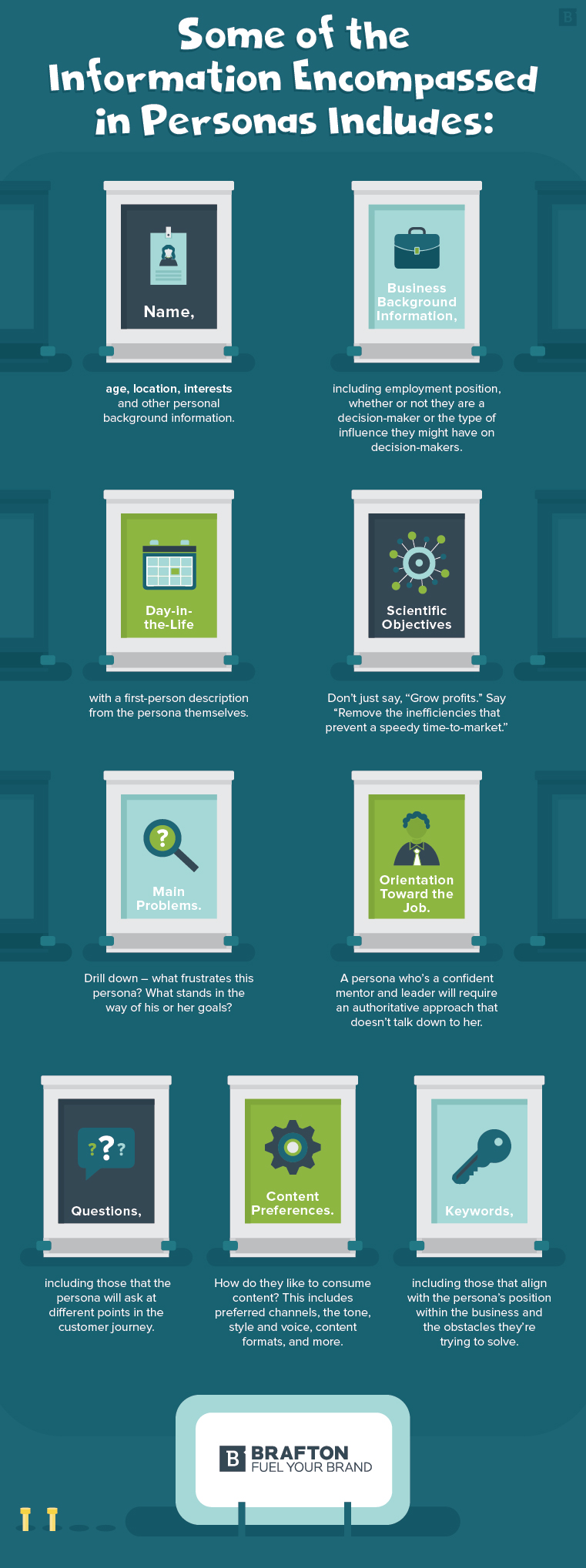
Key Psychographic and Demographic Information
Psychographic and demographic data play a key role in developing a marketing persona. Demographic information includes lifestyle characteristics, such as the age, gender, ethnicity and occupation of your target customer. Psychographic data encompasses the personality traits and values that your target consumers exhibit. From a marketing perspective, psychographic and demographic traits work together to influence purchasing decisions.
Therefore, your persona template will need to include psychographic and demographic data like:
- General attributes: Such as the consumer’s name, age, location, interests and other personal, background information.
- Business background information: Including job title, whether they’re a decision-maker or the type of influence they might have on decision-makers.
- Target audience segment that each persona fits into: Be as specific as possible and don’t hesitate to get granular when defining each segment.
- Day-in-the-life first-person description: This is important, as readers should begin to glean a full understanding of the persona from this perspective.
- Specific objectives: It’s important to be as focused and targeted here as possible. In other words, don’t just say, “Grow profits.” Instead, stating that this type of consumer aims to “remove the inefficiencies that prevent a speedy time-to-market” will be more efficient.
- Main problems: Drill down what frustrates this buyer persona and what stands in the way of his or her goals?
- Orientation toward the job: This part of the customer persona can be incredibly telling. For instance, a young persona who’s new to the job will require more work for awareness and education. A persona who’s been in her career for 15 years and is a confident mentor and leader, on the other hand, will require more of an authoritative tone that doesn’t talk down to her.
- Open-ended questions: Include ones that the persona will ask at different points in the customer journey, and how they relate to his or her personality and position.
- Content preferences: Given what we know about the customer persona, how does he or she like to consume content? This includes preferred channels, content formats and more.
- Tone of voice: How can you style the voice of your content marketing campaigns to ensure they resonate with your personas? Should you maintain an upbeat and friendly demeanor, or should your messaging be serious, professional and technical?
- Keywords: Include words and phrases that align with the persona’s position within the business and the obstacles they’re trying to solve.
How To Generate an Accurate Customer Persona
Once you have these basics covered, you and your team can flesh out your personas even further by asking open-ended questions about each audience persona and the types of strategies that best connect with their interests. This practice can shine a light on the other elements and ideas to include in your buyer persona template, creating a more detailed document for you to work from. The more detailed your template, the better.
For this stage of the process, ask yourself what a typical day looks like for your specific persona. Is your target audience primarily stay-at-home mothers who spend the majority of their day running errands, picking their children up from school and cooking meals for their family? Or are your personas geared toward young adults in college who spend their time in labs or studying in the library? Visualizing the daily activities of your target consumers will allow you to generate accurate customer personas.
Additionally, you should go a step further by including a photo or avatar within your persona template. Taking the time to include a visual with the help of an avatar maker is an incredibly helpful extra step that will enable your team to envision the person they want to connect with.
5 Examples of Persona Templates
Now that you’re up to speed on the importance of customer personas, let’s take a look at a few real-life persona examples, and examine the things that work and where brands could make improvements:
1. Buffer’s Facilities/Operations Manager Fred
In this B2B persona from Buffer, we can get a good idea of who Fred is. For instance, we know he falls into the facility/operations management target audience, is married and has an undergraduate degree. We can see the kind of role Fred has within his business, as well as details about the company itself.
This persona also does a good job of outlining the goals and values Fred has, as well as the obstacles that stand in his way. However, these could be more specific and well defined – instead of just stating that Fred has difficulty “keeping all balls in the air,” the persona could go further to describe the elements associated with this struggle. Is it that Fred struggles with time management? Or that specific inefficiencies make it difficult for him to get everything done?
The same goes with the listed objections: We understand that Fred doesn’t want to look dumb – nobody does! But what types of concepts worry him the most? Is he looking to be more educated about certain things? Or is it that he doesn’t like the use of industry jargon? These are all questions worth asking and answering, which can help you further drill down your messaging and overall appeal.
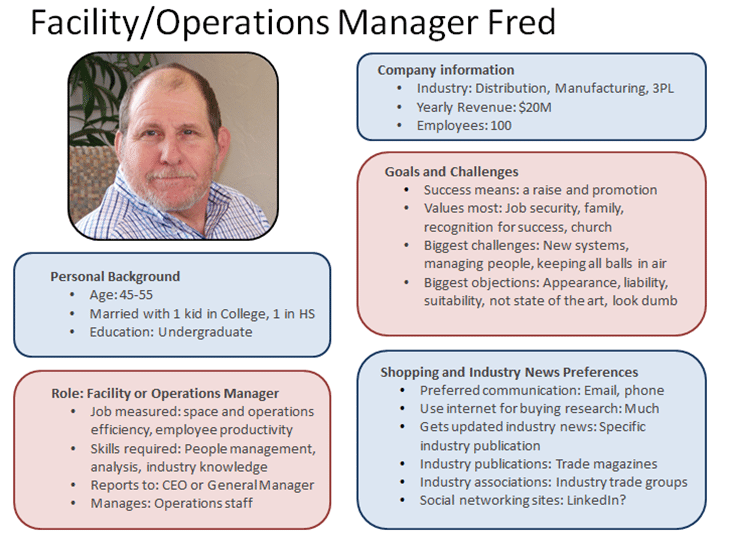
2. Buffer’s Director Diane
Here we have Director Diane, another Buffer persona. Compared to Fred, Diane is much more well-rounded in her B2B persona – we can see what a day is like for her, the problems she runs into, her goals and aspirations, the experience she’s seeking when looking for products and services and more.
It’s interesting here that we also have a mix of bulleted statements, as well as quotes from Diane herself within the PROBLEMS section. It’s very beneficial to let your personas speak for themselves. This little touch goes a long way toward showing the individual’s personality and can provide cues to the type of language the persona uses and what messaging might resonate with him or her. Definitely take the time to create first-person statements from your personas, but ensure that these are carefully thought out and incorporate his or her experience, pain points and motivations.
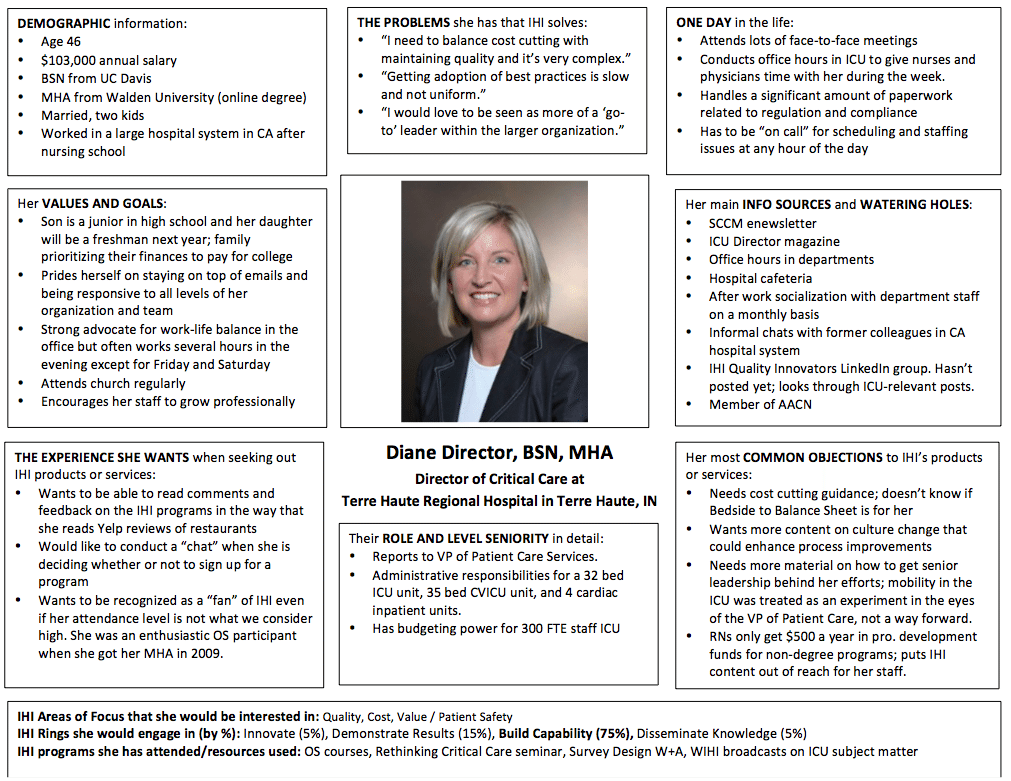
3. Munro’s Narrow-Feet Brandi
This B2C persona from Munro provides a good example of the power of the persona design process. Our previous Diane example is very detailed, but the amount of information, bullet points and boxes can become overwhelming, especially for internal teams that tend to glean more value from short blurbs.
Brandi, on the other hand, shows the important work that designers can bring to the table within persona creation.
In addition to its layout and design, this persona provides another interesting aspect – not only do we have a first-person quote from Brandi herself, but we can also read over quotes from this company’s actual customers. It’s important, though, that should you choose to include statements from your real buyers, that they align and bring value to the persona. There must be some type of strong connection and reason for including these quotes – otherwise you’re just splashing reviews on a page where they don’t belong.
This persona also helps show the importance of ensuring your personas are well defined – the more detail, the better. Although, don’t be fooled – we can understand A LOT about Brandi from her persona here, including her experiences with shoe shopping and the channels she prefers. As Brandi shows, personas can be information-packed without being overly wordy.
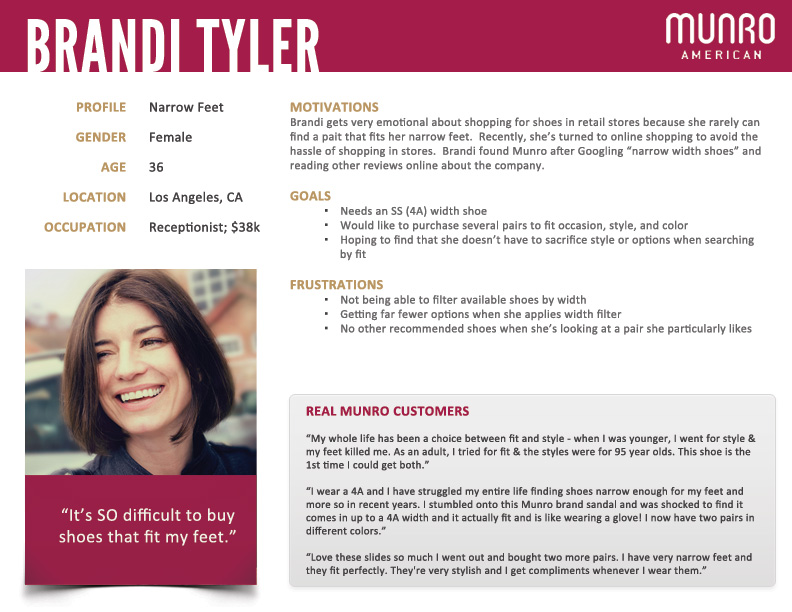
4. Tobi Day’s Record Store Manager
Tobi Day provides us with another example of the impact of persona design. The ways in which you convey persona information is incredibly important – this can’t be overstated. What’s particularly interesting with Tobi is the use of scales and bars to better describe her personality and how she associates with technology. This gives readers a very good idea of where Tobi stands and what’s important to her.
Another key takeaway here is the use of Tier and Archetype information, followed by related traits (ambitious, admired, focused). This provides us with an even deeper understanding of the type of person Tobi is, and the ways in which she might make her purchasing decisions.
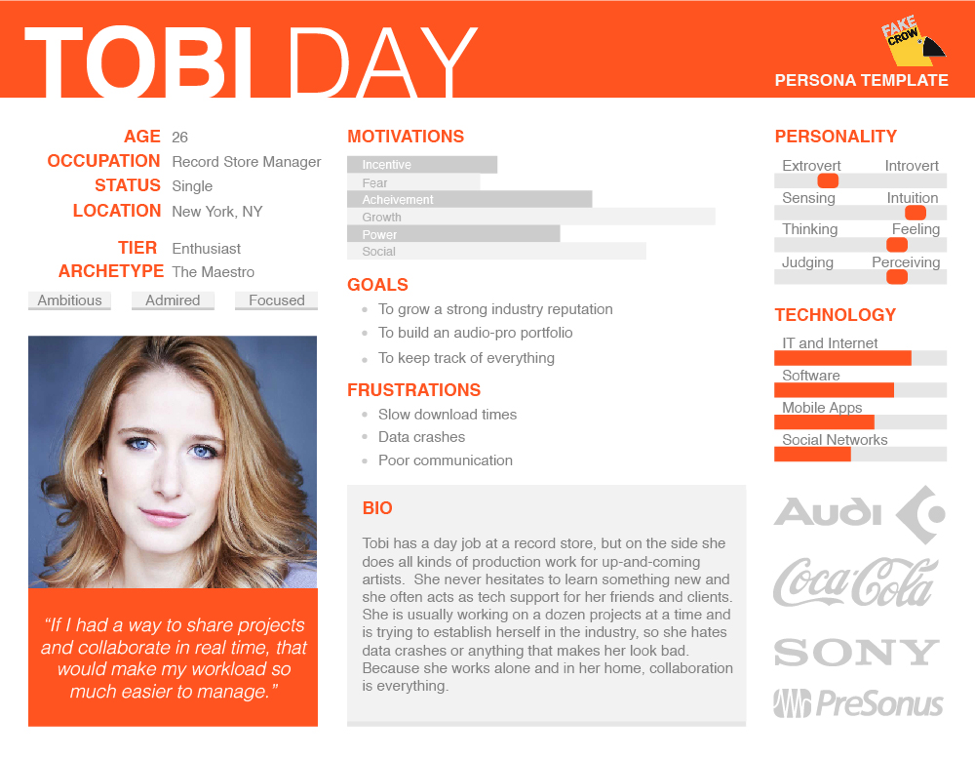
5. Semrush’s Adele
At the end of their list of buyer persona examples, Semrush includes a few unconventional characters to get your creativity flowing — and it’s a great exercise in capturing customers on the page. Although you may not be marketing to Adele herself, it can be helpful to use a familiar personality like hers as practice for your own personas.
While Semrush wrote this particular example with a bit of good humor, there’s still plenty to learn.
For example, under “Brands and influencers,” you’ll find explanations for each list item. The in-depth details here help you learn the why as well as the what — a practice that can be applied to any part of your persona sheet. This makes it easier to deliver content, products and services that meet a customer’s needs and expectations.
Adele fans might also note that there’s more to the artist than this particular angle. That’s a good reminder to treat your personas holistically. Although they might be driven by 1 or 2 very specific things — in this case, heartbreak — there are other parts of their lives, personalities and personal goals that may come in handy as you build relationships.
Just don’t get too focused on any single preference, or real customers might feel like you’re oversimplifying to make them fit into predetermined categories.
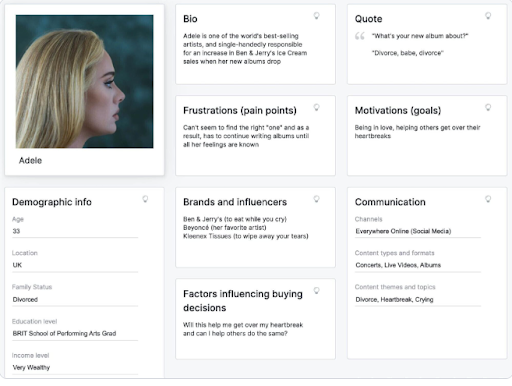
How To Use Personas in Your Digital Marketing Strategy
Your personas are a critical resource that you’ll use again and again to shape the strategies your brand uses to speak to your ideal customers. Once you’ve framed your personas and fully built them out with personality details, it’s time to take things a step further. You and your marketing team can use the information you know about your personas to walk them through different scenarios and apply the resulting lessons to improve your connection with customers.
Here are a few step-by-step instructions for incorporating your personas into your marketing efforts:
- Review your current marketing campaigns: Examine your personas and the ways in which they would react to your existing marketing efforts – you might be surprised by what you learn, and it could provide the perfect opportunity to shift and improve your activities to better suit your audience segments.
- Train team members on the personas: Once you’ve used your audience personas to make any necessary adjustments or improvements to your current campaigns, it’s time to inform your team’s work on upcoming content marketing campaigns. Your personas can tell you a lot about the types of content that will resonate well with each market segment and can help you come up with topic ideas that will capture your readers’ attention and provide them with relevant insights.
- Create visual persona designs: In addition to leveraging your personas to inform your written content, personas are also incredibly beneficial for the design process. Designers can use the details tied to each persona to create visually appealing collateral that maps to the preferences of your specific buyers.
- Create customer journey maps: These user maps help visualize the connection between your brand and your target customer audience. Pairing these maps with your personas can show you the different touchpoints each persona will prefer. This way, you and your marketing team can envision the path of least resistance to get particular personas from “I’m just looking,” to “I’m ready to buy.”
- Develop your products with personas as the central focus: Once your team is aligned in who you’re targeting, you can create products or cater your services to fit the needs and wants of your customer personas.
Create Your Own Personas Now
Here at Brafton, we’ve found success with a 6-step persona process that includes:
- Discovery.
- Review.
- Interview.
- Research.
- Development.
- Presentation.
This helps us create in-depth personas that paint a true and accurate picture of specific buyer personas for our clients.
Ready to create your own personas? We’ve put together this handy Persona Development Template to help you get started.
Download the Persona Development Template:
Editor’s note: Updated February 2022.





